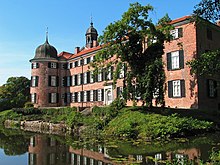Holstein Switzerland




As Holstein Switzerland is Eastern Hills Country Holstein referred to a region in the last Ice Age was formed. The cultural landscape , which is not exactly geographically limited, includes the Holstein Switzerland Nature Park and is one of the most important tourist regions in northern Germany .
Geography and landscape
Holstein Switzerland is located in the east of the federal state Schleswig-Holstein. The region in the historical landscape of Wagrien is not politically or geographically limited. It is largely located in the districts of Ostholstein and Plön , roughly between the cities of Lübeck and Kiel, and extends to the Baltic coast. Larger towns include Bad Malente-Gremsmühlen , Lütjenburg , Oldenburg in Holstein , Preetz and the old residential cities of Eutin and Plön .
The charm of this region is explained by the varied landscape that emerged in the young moraine landscape of the Schleswig-Holstein hill country that was created during the Vistula Ice Age . Smaller forest areas alternate with arable land structured by crooks and the shape of the landscape is determined by low hills, between which there are a multitude of lakes. They include the Great Plöner See , the Dieksee and the Kellersee . Many are traversed by rivers and floodplains, such as the Schwentine , which flows into the Kiel Fjord , or the Kossau , which flows into the Great Inland Lake .
The highest point in Holstein Switzerland is 168 m above sea level. NN high Bungsberg near Schönwalde , the highest elevation in Schleswig-Holstein.
Origin of the name
The name “Holstein Switzerland” goes back to the 19th century , when trips to Switzerland were popular (with the wealthy) ; therefore other regions also endeavored to give themselves the name or suffix “Switzerland”. On May 20, 1885, the Eutinian merchant Johannes Janus opened the “Holsteinische Schweiz” hotel on Kellersee in Krummsee ( Malente ), which enjoyed great popularity. The name of the hotel was initially transferred to the Holsteinische Schweiz train station and later to the entire area.
history
Holstein Switzerland has been settled for several thousand years. In the early Middle Ages , the area was still partly inhabited by the Wends , whose traces can be found in Oldenburg, for example, and which also founded the settlements of Plön and Eutin. The area was colonized in the Middle Ages and belonged to the Frankish Empire from the 9th century . In the late Middle Ages the cities developed into smaller economic centers and the landed gentry expanded their fortified mansions, which at the beginning of the modern era became the basis of noble estates . The manors shaped the landscape as well as the economy from around 1500 to the 20th century. From the 16th century onwards, Plön and Eutin developed into courtly residences for various branches of the Oldenburg family .
A rich cultural life took place on the estates, which can be seen in the transition from the 18th to the 19th century, for example in Eutin, which was known as the Weimar of the North . Until the middle of the 19th century, the area was dominated by Denmark , which first administered the region as a fiefdom and then integrated it into the state as a whole . In 1867, Holstein Switzerland was transferred to Prussia as part of Holstein . After the end of the First World War , the traditional farms were partly dissolved, after the end of the Second World War tourism took on a leading role in the region's economy.
tourism
The agricultural landscape is characterized by large aristocratic estates, historical farms, which are mostly formed by large farms and subsequent mansions. They include, for example, Panker , Testorf , Rantzau or Hagen in Probsteierhagen . Some of the castles such as in Eutin or Plön can be visited, many of the manors can be entered as part of the Schleswig-Holstein Music Festival or various markets. The Good Salzau housed the country's cultural center by 2011.
For hikers, the nature park path connects the five nature parks in Schleswig-Holstein . Holstein Switzerland offers cyclists an extensive network of cycle paths and country roads and country lanes with little traffic. The large lakes are partly visited by excursion boats, and canoeing and other water sports are possible on the waters. Due to the nearby Baltic Sea coast, there are several seaside resorts in the immediate vicinity.
Lakes
In order of their size:
- Great Plön Lake 3000 ha
- Selenter See 2137 ha
- Kellersee 560 ha
- Dieksee 386 ha
- Lanker See 324 ha
- Behler See 277 ha
- Postsee 276 ha
- Kleiner Plöner See 239 ha
- Great Eutin Lake 230 ha
- Stocksee 207 ha
- Trammer Lake 163 ha
- Suhrer See 137 ha
- Vierer See 132 ha
- Schöhsee 78 ha
- Lake Süseler See 77 ha
- Seedorfer See 76 ha
- Sibbersdorfer See 55 ha
- Stendorfer See 54 ha
- Seekamper See 45 ha
- Small Eutin Lake 37 ha
- Ukleisee 32 ha
- Schulensee 13 ha
See also
literature
- Hanns Zimmermann: Holstein Switzerland - origin and spread of a term. In: Jahrbuch für Heimatkunde ( Heimatverband Eutin ). , Eutin 1979, pages 154–158 (on the origin of the name)
Web links
- Holstein Switzerland
- Holstein Switzerland Nature Park
- NABU nature reserve "Suhrer See and Surroundings"
- NABU nature reserve "Islands in the Great Plön Lake and the Störland peninsula"
Individual evidence
- ↑ Federal Agency for Nature Conservation Landscape Profile ( Memento of the original from September 17, 2011 in the Internet Archive ) Info: The archive link was inserted automatically and has not yet been checked. Please check the original and archive link according to the instructions and then remove this notice.
Coordinates: 54 ° 12 ' N , 10 ° 33' E





